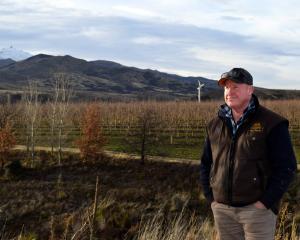
Scientists from AgResearch and its subsidiary Grasslanz Technology have, after a ‘‘miserable start’’, made enough progress in trials to believe Epichloe fungal endophytes can be fused into cereal crops to protect them from pests and diseases.
Modern wheat does not naturally host these endophytes. But the gap has been closed as a result of crossbreeding between modern cereals and Chinese spring wheat by adding or substituting chromosomes so they are compatible with the endophytes taken from wild grass relatives of modern cereals.
Ryegrass pasture persistence and protection have been boosted by selected endophytes, the AR37 strain having contributed an estimated $3.6billion to the economy over the life of its 20-year patent.
Grasslanz Technology chief executive John Caradus said it had been proven in trials that Epichloe endophytes could be combined with some wild grass relatives of cereals which, after crossbreeding, were now close to modern wheats.
He said they were at the stage of making contact with cereal-breeding companies to progress the technology, which could alter the way cereal crops were managed in the future.
In small field trials, Epichloe endophytes were found to give cereals effective protection against rusts and Septoria leaf blotch as well as against insect pests such as the Argentine stem weevil.
The driver was to reduce chemical control as farmers used fungicides and insecticides to control the pests, he said.
‘‘We will be able to reduce the use of synthetic chemistry and still end up with crops that are productive and healthy and naturally resistant. This is a world first. No-one else is doing this, but we have over a period of 18 years and [we have] got to a point we can say we can see the light at the end of the tunnel.’’

‘‘You could argue they did a double take, but the data is unequivocal in that you are reducing rust and Septoria pathogens to almost zero as a result of having these endophytes in a plant. So they were interested. There are still some plant-breeding challenges in maintaining compatibility between the endophyte and their genetics.’’
He said they had been able to work around this through plant-breeding techniques which had given good matches between the wheat host and endophyte.
The idea began in the 1990s after endophyte success in ryegrass improved grass persistence and adaptation.
‘‘The question was asked ‘Could we use these endophytes in cereals?’
‘‘I believe there was an attempt to put some of the ryegrass Epichloes in cereals, but there was no genetic compatibility and they didn’t take. It wasn’t until the early 2000s that the topic came up again and I’d only just started at Grasslanz and we thought we have some money to invest so we may as well give it a shot.
‘‘We realised there wasn’t much point using Epichloes we had out of ryegrass, so we undertook collections in wild relative species of modern cereals.’’
Some of the species came from collections around the world or were found in their host countries, mainly in Asia, and several hundred Epichloe endophyte strains were isolated.
Dr Caradus said the first success came from placing the endophytes ‘‘relatively easily’’ into the animal feed ryecorn.
‘‘Of course, it’s not a high-value crop and it was really a test run to show we can do this. The next move was to look to see if we could get some compatibility with wheat and we struggled with this. It wasn’t until we had a collaboration with a university in Japan with a whole range of Chinese spring wheat lines with introgressed chromosomes from wild relatives of grasses. We sent a couple of guys to Japan with some of these Epichloe strains to inoculate a range of them and rather surprisingly some of them actually were compatible and that’s where it started.’’
He said the endophytic Chinese spring wheat genotypes would hardly be recognised as a wheat plant as they had a stunted stature but, over time, scientists had backcrossed them with modern wheats.
Some of the progeny from those crosses were allowed to self-fertilise, he said.
‘‘We found this was quite a step forward as it’s almost as if the genotype of the host wheat plant and the Epichloe endophyte are getting used to each other and finding a sweet spot so they could exist together.
‘‘We have now got wheat plants with Epichloe endophytes in them that look pretty much like modern wheats. We still have a bit of crossing and breeding work to do, but we are now at the point we are hoping to get some interest from cereal-breeding companies in New Zealand, Australia and elsewhere to take this technology forward.’’
Dr Caradus said a non-exclusive licence would be offered to companies because much of the research was public good and government funded.
Integrating the technology into cereal-breeding programmes by backcrossing was the way forward rather than inoculating them directly into breeding pools.
‘‘We don’t even know what it is, but we have to carry the gene comprising the compatibility between the host plant and the endophyte into these populations.’’
The breeding programmes for annual wheats would have to maintain yields, summer performance and grain quality.
‘‘The reason why these Epichloe endophytes are so effective is they provide a whole range of compounds that provide resistance to insect pests, pathogens and in some instances have provided tolerance to abiotic stresses such as drought and the like.
‘‘The compounds they produce make the plant unpalatable to the pest.’’
So how was that going to affect grain quality and the next slice of bread?
‘‘We don’t know the answer to that yet.
‘‘We just haven’t gone far enough down the path to really get enough grain to test that outcome.’’
Endophytic ryecorn grain, silage and whole plant was fed to sheep with no animal health or welfare issues and the wholegrain from ryecorn and wheat was fed to mice, also with no cause for concern, he said.
‘‘We still have to go through that full cycle of producing enough seed to make a loaf of bread and see what comes out the other end. In the first instance I would see this targeted at feed wheats for animal feed. We can test that relatively easily to make sure there are no ill effects, taking into account all the animal ethics requirements for doing those tests.’’
He pointed out the ryegrass endophyte programme also had significant challenges at first before it delivered insect-resistant strains without animal issues.
The continued use of synthetic chemicals to protect crops against pests and diseases was becoming more difficult because of concerns about risks to human health and changing regulations and some of the chemicals were becoming less effective, he said.















